Goal: Reason regarding interactions
Source: CT151.2S02-43

A
cart of mass 2m collides and sticks to a cart of mass m that is
initially at rest. Which cart exerts the larger force on the other?
- m
- 2m
- Both exert the same force
- Cannot be determined
Goal: Reason regarding interactions
Source: CT151.2S02-43

A
cart of mass 2m collides and sticks to a cart of mass m that is
initially at rest. Which cart exerts the larger force on the other?
Goal: Reasoning regarding the Lorentz force
Source: 283-620 Moving bar magnet and charge
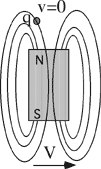
A bar
magnet moving with speed V passes below a stationary charge q. What can
be said about the magnitude of the magnetic force on the bar magnet and
the charge q.
Fbar and Fq are both zero.
Fbar is zero and Fq is not zero.
Fbar is not zero and Fq is zero.
Fbar and Fq are both non-zero.
(4) Many students have a lot of difficulty with this one. All of their
past experience has been with a moving charge in a magnetic field. They
may not think that it is equivalent to view the interaction from the
bar’s frame. Of course, they are correct, but the difference is
unimportant for purposes of recognizing that the force on the charge is
non-zero. They may invoke the third law by rote, without perceiving any
mechanism that could provide a force on the magnet. Discussing this in
some detail is a good idea.
Goal: Problem solving
Source: UMPERG-ctqpe44-46
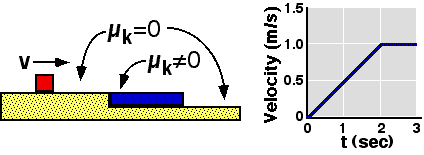
A
block slides along a frictionless surface and onto a slab with a rough
surface. The plot on the right shows the velocity of the blue slab as a
function of time. The slab has mass of 4kg and the block has mass of
2kg. What is the friction force on the small block at t = 1 second?
(5) The acceleration of the slab can be found from the plot. The
only force on the slab in the horizontal direction is the friction force
so it must be responsible for the acceleration. The force on the block
can then be found using the 3rd law.
Goal: Problem solving
Source: UMPERG-ctqpe23
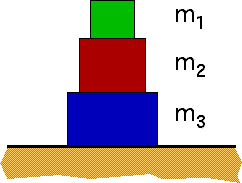
If m2 = 2m1 , m3 = 3m1 and
the force that the surface exerts on the bottom block is 120N, the mass
of the large block is
Use g = 10 N/kg.
(3) the most common other answers are #1 and #6, each of which
represents a typical mistake students make. This problem presents a good
opportunity to encourage students to check their answer.
Goal: Problem solving with dynamics
Source: UMPERG-ctqpe21
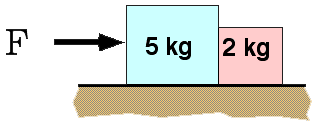
Two blocks rest on a frictionless surface. Both blocks move to the right
with acceleration of 2 m/s2. The force on the big block due
to the small block is
(7) The force on the small block must cause the specified acceleration.
The 3rd law requires that the force on the big block be equal and
opposite. The magnitude is 4N but it is directed to the left.
Goal: Reasoning with Coulomb’s law
Source: UMPERG-A2LEM6
The diagrams show two uniformly charged spheres. The charge on the
right sphere is three times as large as the charge on the left sphere.
The arrows on each charge represent the force on the charge. Which
force diagram best represents the magnitude and direction of the
electric forces on the two spheres?
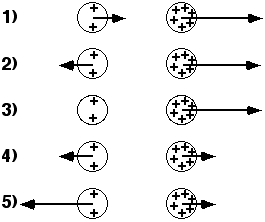
(4) By Newton’s third law the forces are equal and opposite.
Goal: Hone the vector nature of force and interrelate model and procedure forces.
Source: UMPERG
A marble rolls on to a piece of felt and slows down.

Indicate the direction that most nearly corresponds to the direction of
the force that the marble exerts on the felt. If none of the directions
are appropriate, or if the answer cannot be determined, respond (9).

(3) The force the felt exerts on the marble is up (normal force) and to
the left (friction force). Newton’s third law tells us that the force
the marble exerts on the felt must be down and to the right. Students
may focus on the normal force alone (4) or the friction force alone (2).
These are not two forces, but the components of a single force.
Students also find it difficult to extract some information from the
dynamical statement “slows down” and integrate this with the familiar
normal force.
This presents an interesting twist to students. The friction force is
usually formulated in terms of a moving object and a fixed surface.
Students may not know for sure whether there is a friction force on the
felt – the felt is not moving. The analysis on the marble is reasonably
straightforward. Newton’s third law can be used to determine the force
on the felt if the force cannot be determined from the situation
directly.
Question students about how they got their answer. Did they use the
force laws that they learned previously? Did they use Newton’s second
or third laws?
Instead of a marble consider a sliding block and see if students think
differently – some students will have difficulty thinking about friction
with a rolling object.
Goal: Reasoning using the 2nd law.
Source: UMPERG
A tow truck (2,000kg) pushing a car (1000kg) experiences an average
friction force of 13,000N while accelerating from rest to a final
velocity of 36 mi/hr (16 m/s). The air and the road exert an average
resistive force of 1,000N on the car. What force does the car exert on
the tow truck?
(4) The net force on the car and tow truck is 12,000N (13,000N –
1,000N). The acceleration is 4m/s2. The magnitude of the force between
the two vehicles is 5,000N.
Answers are not as important as approach. What did students do to
understand the physical situation? Did they draw pictures. Did they
draw a free-body diagram.
Ask a couple of students to describe how they approached the problem.
Ask them to describe the steps they took without getting into
mathematical details. For example, did they draw a free-body diagram?
What forces did they consider? What system did they analyze?
After a couple of descriptions of how to approach solving the problem,
work through the problem with help from the class.
Goal: Develop the ability to identify 3rd-Law Pairs, the parts of an interaction.
Source: UMPERG-ctqpe42
The two blocks shown below are identical. In case A the block sits on a horizontal surface and in case B the block is in free fall.
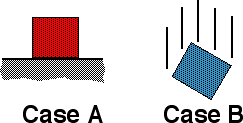
Which of the following statements are true regarding the reaction force to the gravitational force exerted on each block?
(6) The reaction force to the gravitational force exerted (by the
earth) on a block is the gravitational force exerted (by the block) on
the earth. In both cases the reaction force is non zero and because the
blocks are identical the reaction forces for the two cases are
equal.
Newton’s third law can be counter intuitive to many students and the
concept of reaction force can be very confusing. Students often think
that the reaction force to some force exerted on an object is a
balancing force on the same object.
(1) Many students will think the normal force is the reaction force
because it is equal and opposite to the gravitational force exerted on
the block.
(2) Some students may reason that since there is no balancing force
there is no reaction force.
What is a reaction force? What are some examples? Do action-reaction
force pairs act on the same, or different bodies? Why is reaction force
an important idea?
Reaction force is an abstract concept. It cannot be demonstrated. One
needs to make sure students understand its definition. The first step is
to make sure students understand the idea of an interaction: When two
objects affect each other (i.e., influence each others motion, or shape)
then we say that the objects interact. We find that all interactions are
two-way: if the motion/shape of one of the interacting objects is
affected then the motion/shape of the other object is always affected.
We ultimately quantify the effects and refer to the causes of these
effects as forces. An interaction involves two forces, one on each
object. Action-reaction pair refer to the two parts (forces) of an
interaction. Newton’s third law states the relationship between the two
parts (forces) of an interaction: the two forces are equal in magnitude
and point opposite in direction.
Goal: Recognizing how the concept of force relates to interactions.
Source: UMPERG
A bowling ball rolls down an alley and hits a bowling pin. Which
statement below is true about the forces exerted during the impact?
(3); The forces are equal (independent of the masses and motions of the
interacting objects), as required by Newton’s Third Law .
In situations where a heavier, moving object collides with a lighter,
stationary object, students have a very strong intuition that the
heavier, moving object exerts a larger force on the lighter, stationary
object. This intuition is based on experiences like the following: when
a bowling ball hits a pin, the ball continues to move forward and the
pin goes flying off the lane. Students interpret the large change in the
pin’s motion as evidence that the ball (which is heavier than the pin)
exerts a larger force on the pin than vice versa. Often, when a car and
a truck collide, the car suffers much more damage than the truck, and so
students interpret this as evidence that the truck exerts a larger force
on the car. For background reading on helping students overcome this
persistent misconception see Thornton and Sokoloff: Sokoloff, D.R.
& Thornton, R.K. (1997), Using interactive lecture demonstrations to
create an active learning environment, The Physics Teacher, 27, No. 6,
340; and Thornton, R.K. and Sokoloff, D.R. (1998), Assessing student
learning of Newton’s Laws: The force and motion conceptual evaluation
and the evaluation of active learning laboratory and lecture curricula,
American Journal of Physics, 64, 338-352 (1998).
Which object, the bowling ball or the bowling pin, has the larger
acceleration? How do you know?
Which object experiences the larger net force? How do you know?
Would your answer to the original question change if a moving pin hit a
stationary bowling ball?
If you have MBL equipment and force probes, collide a moving cart with a
stationary cart of the same mass. Ask students to compare the forces
exerted on the two carts. Ask students to compare the velocities and
accelerations of the two carts. Repeat using different initial
conditions.
Draw a picture of a large moving cart colliding with a small stationary
cart. Draw a spring between the carts. Ask students how they would
determine the force on each cart given the spring constant and spring
compression.
Take a bathroom scale, place it between two students (a large strong
student and a slight student) and have them push as hard as they can
from either end without making the scale accelerate–observe the scale
reading. Repeat with the scale reversed. Ask if there is much
difference in the scale reading depending on which way the front of the
scale is facing. What does this imply about the forces exerted by the
strong and the slight student on each other?
Commentary:
Answer
(3) Yet another instance of Newton’s Third Law. Some students still
stumble because they the question considers the object exerting the
larger force as opposed to the one having the larger force applied to
it.